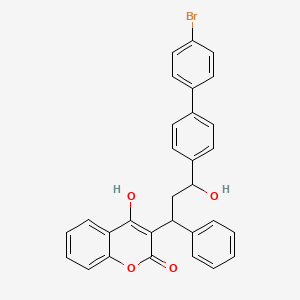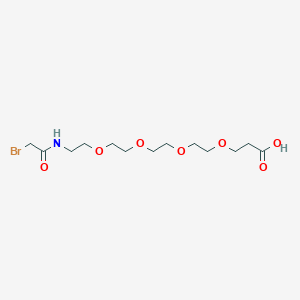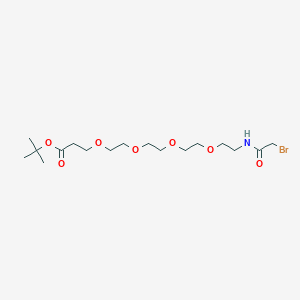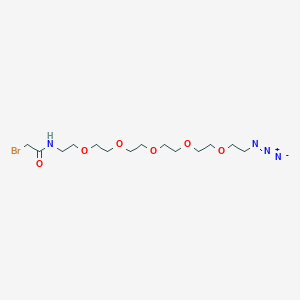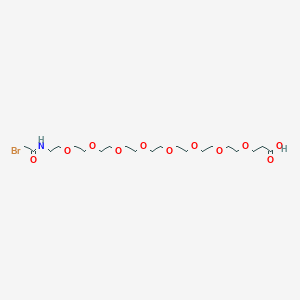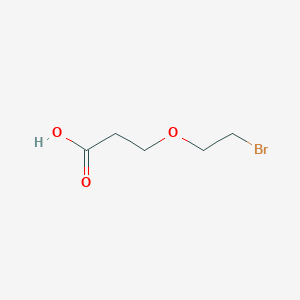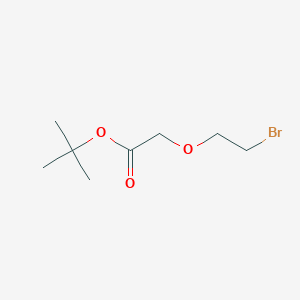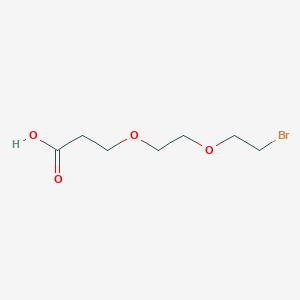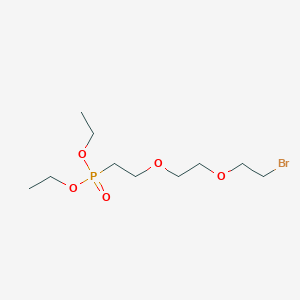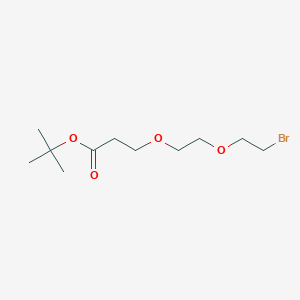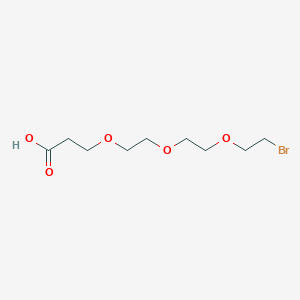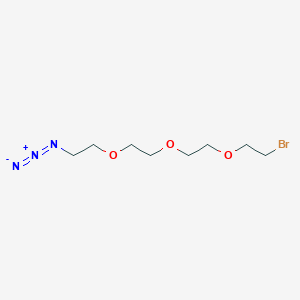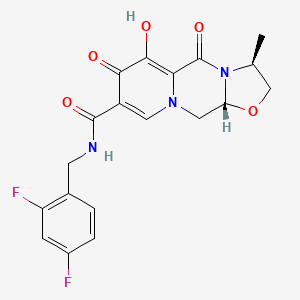
Cabotegravir
Descripción general
Descripción
Cabotegravir es un medicamento antirretroviral utilizado para el tratamiento y la prevención del VIH/SIDA. Es un inhibidor de la transferencia de cadena de la integrasa (INSTI) que evita la integración del genoma viral en el ADN del huésped, inhibiendo así la replicación viral . This compound está disponible en formas orales e inyectables de acción prolongada, lo que lo convierte en una opción versátil para el tratamiento del VIH y la profilaxis previa a la exposición (PrEP) .
Aplicaciones Científicas De Investigación
Cabotegravir tiene una amplia gama de aplicaciones de investigación científica, que incluyen:
Química: Utilizado como compuesto modelo para estudiar inhibidores de la integrasa y sus interacciones con el ADN viral.
Biología: Se estudia por sus efectos sobre la replicación viral y los mecanismos de resistencia.
Industria: Formulado en varios productos farmacéuticos para uso comercial.
Mecanismo De Acción
Cabotegravir ejerce sus efectos al unirse al sitio activo de la enzima integrasa del VIH. Esto evita la transferencia de cadena del genoma viral al ADN del huésped, inhibiendo así la replicación viral . Los objetivos moleculares incluyen la enzima integrasa y el ADN viral, y las vías involucradas están relacionadas con el ciclo de replicación viral .
Análisis Bioquímico
Biochemical Properties
Cabotegravir interacts with the HIV-1 integrase, an enzyme crucial for the replication of the virus . By binding to the active site of this enzyme, this compound prevents the integration of the viral genome into the host genome, thereby inhibiting viral replication .
Cellular Effects
This compound has a significant impact on cells infected with HIV-1. By inhibiting the action of the HIV-1 integrase, this compound prevents the virus from integrating its genetic material into the host cell’s DNA, effectively stopping the replication of the virus . This results in a decrease in viral load and an increase in the number of healthy immune cells.
Molecular Mechanism
This compound exerts its effects at the molecular level by binding to the active site of the HIV-1 integrase . This binding inhibits the action of the enzyme, preventing it from integrating the viral genome into the host cell’s DNA. This inhibition of the integrase enzyme is the primary mechanism by which this compound prevents the replication of the HIV-1 virus .
Temporal Effects in Laboratory Settings
In laboratory settings, this compound has shown sustained antiviral activity. The long-acting injectable formulation of this compound has an elimination half-life of approximately 5.6–11.5 weeks, allowing for infrequent dosing . This long duration of action contributes to the drug’s effectiveness in maintaining viral suppression over time .
Dosage Effects in Animal Models
While specific studies on this compound’s dosage effects in animal models are limited, a dose-optimization study of this compound in a mouse pregnancy model aimed to determine the dose that would yield plasma drug concentrations similar to those observed in humans .
Metabolic Pathways
This compound is primarily metabolized by uridine diphosphate glucuronosyltransferase 1A1 (UGT1A1) . This metabolic pathway involves the addition of a glucuronic acid group to this compound, making it more water-soluble and thus easier for the body to eliminate .
Transport and Distribution
Following intramuscular administration, this compound is readily absorbed and distributed within the body . It circulates mainly in the plasma, with limited partitioning in blood cells . Regarding tissue distribution, this compound is found mainly in the lung, liver, renal and adrenal medulla, and skin, with limited penetration in the brain .
Métodos De Preparación
Rutas de Síntesis y Condiciones de Reacción
La síntesis de cabotegravir involucra múltiples pasos, comenzando con materiales de partida disponibles comercialmenteLas condiciones de reacción típicamente involucran el uso de bases fuertes, como el hidruro de sodio, y varios solventes orgánicos .
Métodos de Producción Industrial
La producción industrial de this compound sigue rutas sintéticas similares pero a mayor escala. El proceso está optimizado para el rendimiento y la pureza, con estrictas medidas de control de calidad implementadas. El producto final se formula en tabletas o suspensiones inyectables, dependiendo del uso previsto .
Análisis De Reacciones Químicas
Tipos de Reacciones
Cabotegravir experimenta varios tipos de reacciones químicas, que incluyen:
Oxidación: this compound puede oxidarse para formar varios metabolitos.
Reducción: Las reacciones de reducción pueden modificar los grupos funcionales en la molécula de this compound.
Sustitución: Las reacciones de sustitución pueden introducir diferentes grupos funcionales en la estructura de this compound.
Reactivos y Condiciones Comunes
Los reactivos comunes utilizados en estas reacciones incluyen agentes oxidantes como el peróxido de hidrógeno, agentes reductores como el borohidruro de sodio y varios solventes orgánicos. Las condiciones de reacción generalmente se controlan para garantizar que el producto deseado se obtenga con alta pureza .
Principales Productos Formados
Los principales productos formados a partir de estas reacciones incluyen varios metabolitos y derivados de this compound, que pueden tener diferentes propiedades farmacológicas .
Comparación Con Compuestos Similares
Compuestos Similares
Dolutegravir: Otro inhibidor de la integrasa con un mecanismo de acción similar.
Raltegravir: El primer inhibidor de la integrasa aprobado para el tratamiento del VIH.
Elvitegravir: Un inhibidor de la integrasa utilizado en combinación con otros medicamentos antirretrovirales.
Singularidad de Cabotegravir
This compound es único debido a su formulación inyectable de acción prolongada, que proporciona niveles sostenidos de fármaco y reduce la necesidad de dosificación diaria. Esto lo hace particularmente útil para las personas que tienen dificultades para adherirse a los regímenes de medicación diaria .
Propiedades
IUPAC Name |
(3R,6S)-N-[(2,4-difluorophenyl)methyl]-10-hydroxy-6-methyl-8,11-dioxo-4-oxa-1,7-diazatricyclo[7.4.0.03,7]trideca-9,12-diene-12-carboxamide | |
|---|---|---|
| Source | PubChem | |
| URL | https://pubchem.ncbi.nlm.nih.gov | |
| Description | Data deposited in or computed by PubChem | |
InChI |
InChI=1S/C19H17F2N3O5/c1-9-8-29-14-7-23-6-12(16(25)17(26)15(23)19(28)24(9)14)18(27)22-5-10-2-3-11(20)4-13(10)21/h2-4,6,9,14,26H,5,7-8H2,1H3,(H,22,27)/t9-,14+/m0/s1 | |
| Source | PubChem | |
| URL | https://pubchem.ncbi.nlm.nih.gov | |
| Description | Data deposited in or computed by PubChem | |
InChI Key |
WCWSTNLSLKSJPK-LKFCYVNXSA-N | |
| Source | PubChem | |
| URL | https://pubchem.ncbi.nlm.nih.gov | |
| Description | Data deposited in or computed by PubChem | |
Canonical SMILES |
CC1COC2N1C(=O)C3=C(C(=O)C(=CN3C2)C(=O)NCC4=C(C=C(C=C4)F)F)O | |
| Source | PubChem | |
| URL | https://pubchem.ncbi.nlm.nih.gov | |
| Description | Data deposited in or computed by PubChem | |
Isomeric SMILES |
C[C@H]1CO[C@H]2N1C(=O)C3=C(C(=O)C(=CN3C2)C(=O)NCC4=C(C=C(C=C4)F)F)O | |
| Source | PubChem | |
| URL | https://pubchem.ncbi.nlm.nih.gov | |
| Description | Data deposited in or computed by PubChem | |
Molecular Formula |
C19H17F2N3O5 | |
| Source | PubChem | |
| URL | https://pubchem.ncbi.nlm.nih.gov | |
| Description | Data deposited in or computed by PubChem | |
DSSTOX Substance ID |
DTXSID50146982 | |
| Record name | GSK-1265744 | |
| Source | EPA DSSTox | |
| URL | https://comptox.epa.gov/dashboard/DTXSID50146982 | |
| Description | DSSTox provides a high quality public chemistry resource for supporting improved predictive toxicology. | |
Molecular Weight |
405.4 g/mol | |
| Source | PubChem | |
| URL | https://pubchem.ncbi.nlm.nih.gov | |
| Description | Data deposited in or computed by PubChem | |
Mechanism of Action |
Cabotegravir binds to the active site of HIV integrase, preventing strand transfer of the viral genome into the host genome, and preventing replication of the virus. | |
| Record name | Cabotegravir | |
| Source | DrugBank | |
| URL | https://www.drugbank.ca/drugs/DB11751 | |
| Description | The DrugBank database is a unique bioinformatics and cheminformatics resource that combines detailed drug (i.e. chemical, pharmacological and pharmaceutical) data with comprehensive drug target (i.e. sequence, structure, and pathway) information. | |
| Explanation | Creative Common's Attribution-NonCommercial 4.0 International License (http://creativecommons.org/licenses/by-nc/4.0/legalcode) | |
CAS No. |
1051375-10-0 | |
| Record name | Cabotegravir | |
| Source | CAS Common Chemistry | |
| URL | https://commonchemistry.cas.org/detail?cas_rn=1051375-10-0 | |
| Description | CAS Common Chemistry is an open community resource for accessing chemical information. Nearly 500,000 chemical substances from CAS REGISTRY cover areas of community interest, including common and frequently regulated chemicals, and those relevant to high school and undergraduate chemistry classes. This chemical information, curated by our expert scientists, is provided in alignment with our mission as a division of the American Chemical Society. | |
| Explanation | The data from CAS Common Chemistry is provided under a CC-BY-NC 4.0 license, unless otherwise stated. | |
| Record name | Cabotegravir [USAN:INN] | |
| Source | ChemIDplus | |
| URL | https://pubchem.ncbi.nlm.nih.gov/substance/?source=chemidplus&sourceid=1051375100 | |
| Description | ChemIDplus is a free, web search system that provides access to the structure and nomenclature authority files used for the identification of chemical substances cited in National Library of Medicine (NLM) databases, including the TOXNET system. | |
| Record name | Cabotegravir | |
| Source | DrugBank | |
| URL | https://www.drugbank.ca/drugs/DB11751 | |
| Description | The DrugBank database is a unique bioinformatics and cheminformatics resource that combines detailed drug (i.e. chemical, pharmacological and pharmaceutical) data with comprehensive drug target (i.e. sequence, structure, and pathway) information. | |
| Explanation | Creative Common's Attribution-NonCommercial 4.0 International License (http://creativecommons.org/licenses/by-nc/4.0/legalcode) | |
| Record name | GSK-1265744 | |
| Source | EPA DSSTox | |
| URL | https://comptox.epa.gov/dashboard/DTXSID50146982 | |
| Description | DSSTox provides a high quality public chemistry resource for supporting improved predictive toxicology. | |
| Record name | (3S, 11AR)-N-[(2,4-DIFLUOROPHENYL) METHYL] - 6- HYDROXY-3-METHYL-5,7-DIOXO-2,3,5,7,11,11A- HEXADROOXAZOLO[3,2-A] PYRIDO[1,2-D]PYRAZINE-8-CARBOXAMIDE | |
| Source | European Chemicals Agency (ECHA) | |
| URL | https://echa.europa.eu/information-on-chemicals | |
| Description | The European Chemicals Agency (ECHA) is an agency of the European Union which is the driving force among regulatory authorities in implementing the EU's groundbreaking chemicals legislation for the benefit of human health and the environment as well as for innovation and competitiveness. | |
| Explanation | Use of the information, documents and data from the ECHA website is subject to the terms and conditions of this Legal Notice, and subject to other binding limitations provided for under applicable law, the information, documents and data made available on the ECHA website may be reproduced, distributed and/or used, totally or in part, for non-commercial purposes provided that ECHA is acknowledged as the source: "Source: European Chemicals Agency, http://echa.europa.eu/". Such acknowledgement must be included in each copy of the material. ECHA permits and encourages organisations and individuals to create links to the ECHA website under the following cumulative conditions: Links can only be made to webpages that provide a link to the Legal Notice page. | |
| Record name | CABOTEGRAVIR | |
| Source | FDA Global Substance Registration System (GSRS) | |
| URL | https://gsrs.ncats.nih.gov/ginas/app/beta/substances/HMH0132Z1Q | |
| Description | The FDA Global Substance Registration System (GSRS) enables the efficient and accurate exchange of information on what substances are in regulated products. Instead of relying on names, which vary across regulatory domains, countries, and regions, the GSRS knowledge base makes it possible for substances to be defined by standardized, scientific descriptions. | |
| Explanation | Unless otherwise noted, the contents of the FDA website (www.fda.gov), both text and graphics, are not copyrighted. They are in the public domain and may be republished, reprinted and otherwise used freely by anyone without the need to obtain permission from FDA. Credit to the U.S. Food and Drug Administration as the source is appreciated but not required. | |
Q1: What is the mechanism of action of cabotegravir?
A1: this compound is a potent integrase strand transfer inhibitor (INSTI) that acts by binding to the integrase enzyme of HIV-1. This binding prevents the integration of viral DNA into the host cell's genome, thus blocking viral replication. [, , , ]
Q2: How does the inhibition of HIV-1 integrase by this compound affect the virus lifecycle?
A2: By inhibiting integrase, this compound prevents the formation of proviral DNA, which is essential for the production of new viral proteins and the establishment of a persistent infection. [, , ]
Q3: Does this compound demonstrate activity against HIV-2?
A3: Yes, in vitro studies have demonstrated that this compound exhibits antiviral activity against HIV-2 isolates, with EC50 values in the low to subnanomolar range, comparable to its activity against HIV-1. []
Q4: What is the molecular formula and weight of this compound?
A4: this compound has the molecular formula C28H27F2N7O4 and a molecular weight of 555.56 g/mol. []
Q5: How do structural modifications of this compound influence its activity and solubility?
A5: While the exact SAR of this compound's solubility is not fully elucidated in these papers, research suggests that specific structural features contribute to its low aqueous solubility, which is crucial for its long-acting formulation. [] One study investigating resistance mechanisms identified that specific mutations in the HIV integrase enzyme, like L74I/Q148R, can reduce this compound's susceptibility. []
Q6: How is this compound formulated for long-acting administration?
A6: this compound is formulated as a nanosuspension for long-acting intramuscular (IM) injection. This formulation allows for slow drug release from the muscle, resulting in sustained therapeutic concentrations for extended periods. [, , ]
Q7: How does the stability of this compound in its injectable formulation compare to other formulations?
A7: The long-acting injectable formulation of this compound exhibits a significantly longer half-life compared to the oral formulation, allowing for less frequent dosing intervals (monthly or even bimonthly). [, ] This difference in half-life is attributed to the slow release of the drug from the intramuscular depot.
Q8: How is this compound absorbed, distributed, metabolized, and excreted (ADME)?
A8: this compound is primarily metabolized by UDP-glucuronosyltransferase (UGT) 1A1 and UGT1A9 enzymes in the liver. [] Following oral administration, approximately 27% of the dose is recovered in the urine, primarily as the glucuronide metabolite (M1). [] this compound demonstrates minimal intestinal and renal metabolism. []
Q9: What is the impact of renal impairment on this compound exposure?
A9: Severe renal impairment (creatinine clearance <30 mL/min) does not significantly impact plasma this compound exposure. Therefore, dose adjustment is not required in patients with renal impairment who are not on dialysis. []
Q10: How does a high-fat meal affect the pharmacokinetics of this compound?
A10: A high-fat meal moderately increases this compound exposure (area under the curve and maximum concentration) by approximately 14%, which is not considered clinically significant. []
Q11: How does obesity impact the exposure of long-acting this compound and rilpivirine?
A12: Studies using physiologically based pharmacokinetic modeling suggest that obesity can reduce the exposure of both drugs, particularly in individuals with a BMI > 35 kg/m2. This reduction might lead to suboptimal drug concentrations, especially with less frequent dosing schedules. []
Q12: Does age affect the pharmacokinetics of long-acting this compound and rilpivirine?
A13: PBPK modeling studies suggest that older individuals may have higher exposure to LA this compound/rilpivirine compared to younger individuals. This difference highlights the need to consider age-related pharmacokinetic variations in this population. []
Q13: What is the impact of oral lead-in on long-acting this compound pharmacokinetics?
A14: Studies have shown that the use of an oral lead-in before initiating long-acting this compound injections does not significantly affect the drug's overall exposure. This finding supports the optional use of oral lead-in. []
Q14: What preclinical studies have been conducted to evaluate the efficacy of long-acting this compound?
A15: Preclinical studies in macaque models demonstrated that long-acting this compound provided high protection against both rectal and vaginal HIV transmission at clinically achievable drug concentrations. These findings supported the drug's development for pre-exposure prophylaxis (PrEP). [, ]
Q15: What are the key findings from clinical trials evaluating long-acting this compound for HIV treatment and prevention?
A16:* HPTN 083 & HPTN 084: Demonstrated superior efficacy of long-acting this compound compared to daily oral tenofovir disoproxil fumarate–emtricitabine (TDF–FTC) for PrEP in men who have sex with men (MSM), transgender women, and cisgender women in sub-Saharan Africa. [, ] * ECLAIR: Phase IIa study showcasing the safety, tolerability, and acceptability of this compound LA for PrEP in healthy men. []* LATTE: Phase IIb study demonstrating the efficacy of daily oral this compound + rilpivirine compared to efavirenz + 2 NRTIs in treatment-naïve adults with HIV-1. []* LATTE-2: Phase IIb study showing comparable efficacy of long-acting this compound + rilpivirine (dosed every 4 or 8 weeks) to daily oral ART in treatment-naïve adults with HIV-1. [] * FLAIR: Phase III study demonstrating non-inferiority of monthly long-acting this compound + rilpivirine versus daily oral dolutegravir/abacavir/lamivudine for maintaining virologic suppression in treatment-naïve individuals. []* ATLAS: Phase III study confirming the efficacy of monthly this compound + rilpivirine injections in maintaining HIV suppression in treatment-experienced patients. []* ATLAS-2M: Supported the efficacy of this compound + rilpivirine injections administered every 8 weeks. []
Q16: What are the known resistance mechanisms to this compound?
A17: Resistance to this compound can emerge through mutations in the HIV-1 integrase gene. While the L74I polymorphism alone doesn't significantly impact this compound susceptibility, the combination of L74I with Q148R mutations can lead to reduced susceptibility. [] Additionally, mutations like E138A/G140A/G163R/Q148R or E138K/G140A/S147G/Q148K have been shown to confer high-level resistance to both this compound and bictegravir, highlighting potential cross-resistance within the INSTI class. []
Q17: Does the HIV-1 subtype influence the risk of treatment failure with this compound + rilpivirine?
A18: Yes, clinical trials have shown that individuals infected with HIV-1 subtypes A6/A1, initially classified as A1, have an increased risk of virologic failure when treated with this compound + rilpivirine. This finding emphasizes the importance of considering HIV-1 subtype when prescribing this treatment. [, ]
Q18: What are the most common side effects associated with long-acting this compound injections?
A19: The most commonly reported side effect is injection site reactions (ISRs), including pain, induration, and swelling. These reactions are typically mild to moderate in severity and tend to decrease in frequency with subsequent injections. [, ]
Q19: What analytical techniques are used to quantify this compound in biological samples?
A20: Several analytical methods, including high-performance liquid chromatography (HPLC) coupled with mass spectrometry (MS) and tandem mass spectrometry (MS/MS), have been developed and validated for the quantification of this compound in biological samples. [, , ] These methods demonstrate high sensitivity, accuracy, and reproducibility for therapeutic drug monitoring.
Q20: Why is the low solubility of this compound important for its long-acting formulation?
A21: The low solubility of this compound in aqueous solutions is a key factor contributing to its slow and sustained release from the intramuscular injection site, allowing for a longer duration of action and less frequent dosing. [, ]
Descargo de responsabilidad e información sobre productos de investigación in vitro
Tenga en cuenta que todos los artículos e información de productos presentados en BenchChem están destinados únicamente con fines informativos. Los productos disponibles para la compra en BenchChem están diseñados específicamente para estudios in vitro, que se realizan fuera de organismos vivos. Los estudios in vitro, derivados del término latino "in vidrio", involucran experimentos realizados en entornos de laboratorio controlados utilizando células o tejidos. Es importante tener en cuenta que estos productos no se clasifican como medicamentos y no han recibido la aprobación de la FDA para la prevención, tratamiento o cura de ninguna condición médica, dolencia o enfermedad. Debemos enfatizar que cualquier forma de introducción corporal de estos productos en humanos o animales está estrictamente prohibida por ley. Es esencial adherirse a estas pautas para garantizar el cumplimiento de los estándares legales y éticos en la investigación y experimentación.


